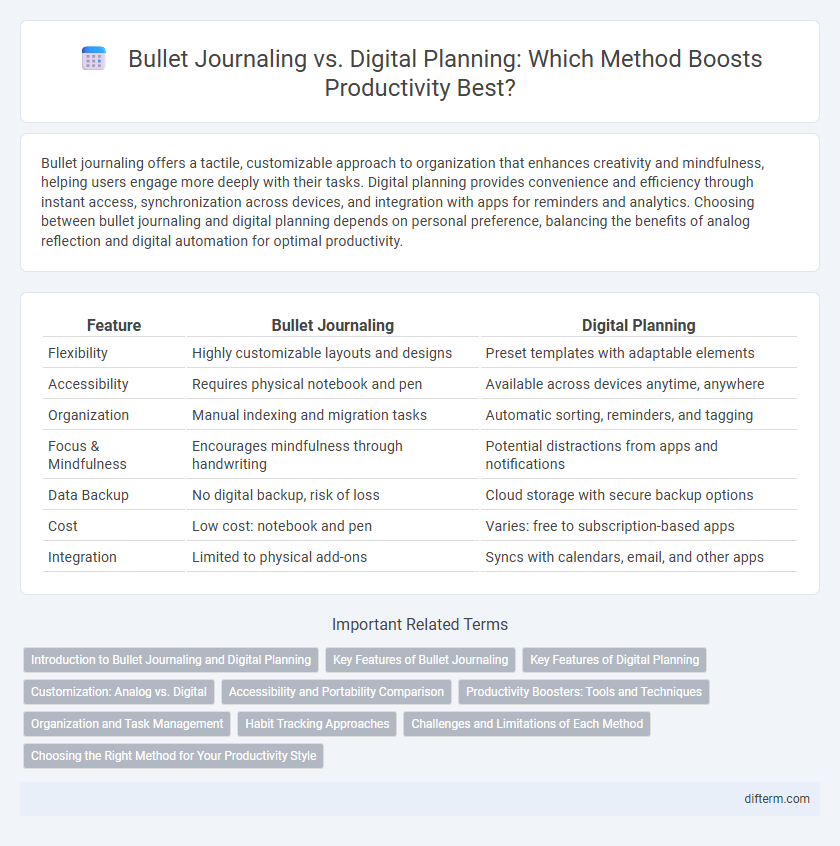Bullet journaling offers a tactile, customizable approach to organization that enhances creativity and mindfulness, helping users engage more deeply with their tasks. Digital planning provides convenience and efficiency through instant access, synchronization across devices, and integration with apps for reminders and analytics. Choosing between bullet journaling and digital planning depends on personal preference, balancing the benefits of analog reflection and digital automation for optimal productivity.
Table of Comparison
| Feature | Bullet Journaling | Digital Planning |
|---|---|---|
| Flexibility | Highly customizable layouts and designs | Preset templates with adaptable elements |
| Accessibility | Requires physical notebook and pen | Available across devices anytime, anywhere |
| Organization | Manual indexing and migration tasks | Automatic sorting, reminders, and tagging |
| Focus & Mindfulness | Encourages mindfulness through handwriting | Potential distractions from apps and notifications |
| Data Backup | No digital backup, risk of loss | Cloud storage with secure backup options |
| Cost | Low cost: notebook and pen | Varies: free to subscription-based apps |
| Integration | Limited to physical add-ons | Syncs with calendars, email, and other apps |
Introduction to Bullet Journaling and Digital Planning
Bullet journaling offers a customizable and tactile approach to productivity by combining task lists, calendars, and notes in a physical notebook, enhancing memory retention and personal expression. Digital planning utilizes apps and software like Todoist, Trello, and Notion to provide interactive, cloud-synced tools for organizing tasks, events, and projects with real-time updates and collaboration features. Both methods aim to optimize time management, prioritize goals, and boost efficiency, catering to different preferences for analog or digital productivity systems.
Key Features of Bullet Journaling
Bullet journaling offers unparalleled customization through its analog system, allowing users to create personalized layouts for task tracking, habit monitoring, and goal setting with simple tools like pens and notebooks. Its emphasis on mindfulness and creativity enhances focus and productivity by combining planning with reflection and artistic expression. Unlike digital planning, bullet journaling encourages tactile engagement, which can improve memory retention and increase motivation to complete tasks effectively.
Key Features of Digital Planning
Digital planning offers real-time synchronization across multiple devices, ensuring seamless access to schedules and notes anytime and anywhere. Customizable templates and integration with calendar apps, task managers, and reminders enhance organization and time management efficiency. Features like searchable content, automated reminders, and collaboration tools streamline productivity for individuals and teams.
Customization: Analog vs. Digital
Bullet journaling offers unparalleled customization through free-form layouts, personalized symbols, and hand-drawn elements that adapt to individual productivity needs. Digital planning provides dynamic customization options with templates, widgets, and integration features that streamline task management and sync across devices. Both methods enhance productivity by allowing users to tailor their planning systems to fit unique workflows and preferences.
Accessibility and Portability Comparison
Bullet journaling offers unparalleled accessibility with no reliance on batteries or software, making it usable anytime and anywhere without technical barriers. Digital planning provides superior portability by consolidating schedules, tasks, and notes into one device that syncs across multiple platforms for seamless updates on the go. Each method caters to different user needs: bullet journaling appeals to those valuing tactile, distraction-free organization, while digital planning suits users prioritizing quick access and integration across devices.
Productivity Boosters: Tools and Techniques
Bullet journaling enhances productivity by promoting mindfulness and customization through physical task tracking, habit monitoring, and rapid logging. Digital planning offers seamless integration with apps, automated reminders, and cloud synchronization for efficient time management and collaborative workflows. Leveraging tools like analog note-taking and digital notifications maximizes productivity by combining tactile engagement with technological convenience.
Organization and Task Management
Bullet journaling enhances organization by offering a tactile, customizable method to track tasks and prioritize goals, fostering mindfulness and reducing digital distractions. Digital planning streamlines task management through features like reminders, calendar integrations, and real-time syncing across devices, promoting efficiency and accessibility. Both methods improve productivity by catering to different workflow preferences and helping maintain focus on task completion.
Habit Tracking Approaches
Bullet journaling offers a tactile habit tracking approach, using customizable symbols and layouts to visualize progress and patterns over time. Digital planning apps provide automated reminders and analytics, enabling users to track habits with precision and receive data-driven insights for improvement. Combining tactile engagement with digital efficiency enhances overall habit formation and productivity.
Challenges and Limitations of Each Method
Bullet journaling faces challenges such as time-consuming manual entry and difficulty in quick editing or task reorganization, limiting flexibility for fast-paced workflows. Digital planning often encounters issues like dependence on battery life, potential distractions from notifications, and sometimes overwhelming interface complexity hindering efficient use. Both methods require consistent discipline but differ in adaptability, with bullet journaling favoring tactile engagement and digital planning offering integration with other productivity tools.
Choosing the Right Method for Your Productivity Style
Bullet journaling offers tactile engagement and customization that enhances memory retention and creativity for hands-on planners. Digital planning provides seamless synchronization, automation, and access across devices, ideal for tech-savvy users who prioritize efficiency and real-time updates. Choosing the right productivity method depends on whether tactile interaction or digital convenience better aligns with your personal organization preferences and workflow requirements.
Bullet journaling vs Digital planning Infographic

 difterm.com
difterm.com